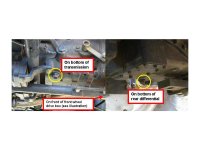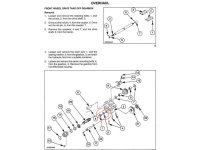I have a New Holland TC35DA Hydrostat with 345 hours, and according to my owners manual, I need to change the Hydraulic Oil. There are 2 filters, one called the Hydraulic Filter, and the other called the HST filter. I've located these; seems they're not the easiest to get to; but I need to know if they are removed by Spin Off with a common Oil Filter wrench? and if so, I assume normal threads such that to remove the filters you would turn same direction that you would unscrew a wood screw from a piece of wood?? In addition to those questions, I would very much appreciate any advice that you may have before I tackle this project. I have never done a hydraulic oil change before. Thank you.
You are using an out of date browser. It may not display this or other websites correctly.
You should upgrade or use an alternative browser.
You should upgrade or use an alternative browser.
Oil & Fuel Hydraulic Oil Replacement
- Thread starter rchatel
- Start date
/ Hydraulic Oil Replacement
#1
gengine
Platinum Member
Typically, it should be the same as changing engine oil, just two filters instead of one. I don't know anything about your tractor, but it is new enough that they are spin-on and correct threads. I'm sure someone will chime in that knows for sure. Another way is to go get the new filters and look at them to see what they are. Your dealer will know which filters you need, as well as your local parts shop can look them up to get you the correct ones.
billybobjimmyjoejack
Silver Member
- Joined
- Aug 16, 2011
- Messages
- 142
- Tractor
- Ford/New Holland 1715
Your owners manual should give the capacity and type of oil for your system. Once the oil starts to flow it could make a real mess if you try to put the plug back in. So it is real important to have enough drain pan capacity ready before you start.
jinman
Rest in Peace
- Joined
- Feb 23, 2001
- Messages
- 21,008
- Location
- Texas - Wise County - Sunset
- Tractor
- NHTC45D, NH LB75B, Ford Jubilee
I have a New Holland TC35DA Hydrostat with 345 hours, and according to my owners manual, I need to change the Hydraulic Oil. There are 2 filters, one called the Hydraulic Filter, and the other called the HST filter. I've located these; seems they're not the easiest to get to; but I need to know if they are removed by Spin Off with a common Oil Filter wrench?
Changing the hydraulic oil in your tractor is a simple job if you do all the preparation steps ahead of time. As with many things, you can have a mess on your hands if you don't know what to expect and have all you need right at hand. This info has been covered many times in the New Holland Owning/Operating forums, but I'll go over it again here and not make you search for it.
I'll try to list things below. If someone wants to add to my list, please do.
1. Get the proper oil filter wrench. Harbor Freight sells the one below, but all auto parts stores like AutoZone, O'Reilly's, and NAPA will have a similar wrench. This one at Harbor Freight is about $7

You will find the large oil filter by the right rear wheel is not too tight, but the one for the HST on the left side of the engine will probably feel like it was put on by a 500 lb gorilla. These filters are very tight because they have to withstand 250+ psi on the HST tractors. When you put it back on, you'll lube the gasket and tighten this filter much tighter than you would an engine oil filter. Make it as tight as you can get it by hand. Don't use tools to tighten it unless it leaks, but get it as tight as you can by hand.
2. Next, let's talk about draining oil. The manual says your reservoir holds about 10 gallons of oil, but most of us find that we can only drain 7-1/2 to 8 gallons. That's because oil will be trapped in hydraulic cylinders, the HST transmission, and other locations. I suggest you go ahead and buy 10 gallons because you may need to top off your power steering or front differential. It's always good to have extra hydraulic oil on hand. New Holland's oil is Multi-G 134. It's pretty expensive, but if your tractor is in warranty, I would suggest you just go ahead and buy the New Holland oil. If you are out of warranty, then you can go to TSC, NAPA, or even AutoZone and buy "Premium Transmission Fluid." Don't buy the oil marked "hydraulic fluid." You want an oil that has all the additives for use in HST transmissions. It's a little more expensive, but ensures you are getting the correct oil.
3. Now, you'll need a funnel with a long snout also. One with a long flexible snout is perfect. Also, stop by the dollar store and buy yourself a 2 to 4 quart sized pitcher with a handle. You'll use this as a decanter. Fill this from the 5-gallon buckets instead of trying to lift up a bucket and hold it while you pour in the new fluid. The fill location on the top of the differential housing below your fuel tank is not easy to get to. The flex-snout funnel and decanter makes refilling at this spot a snap.
4. If you don't have two empty oil drain pans that will hold 5 gal each, then you can use 5-gal buckets that are available at Home Depot and other box stores. Old 5-gal paint cans are good too. Line these buckets with trash bags. I use tall kitchen bags and double bag each can. With this method, when you finish using the buckets, you can pour the used oil into containers and then simply remove the trash bags and toss them into the garbage can. You won't have oily buckets to clean up.
5. Now, to locate your drain points. There are three drain points for fluid as shown below. One is under your transmission, one is under the differential, and the other one is on the gearbox that drives the driveline going up to your front wheels. The photo and illustarations attached show the locations. The drain on the front wheel drive box is the lowest and will get the most fluid drained out of your reservoir.
Find a wrench that will fit these drain plugs and have it handy. You can use an adjustable wrench, but that is also a good way to round off the hex head on the bolts. I recommend a wrench. I believe they are 17 mm or 19 mm, but I don't remember for sure. A regular 1/2" drive metric socket set should have a size that fits.
When you remove the first plug, you'll get a rush of fluid. I guarantee it will be more than 6 gallons, so have the second bucket close to scoot under the drain as you scoot the near-full bucket away. You'll spill a few drops of fluid, so having some cardboard under the tractor also helps catch the small spills. If you have a very large catch pan over 8 gallons, you won't have to worry about this, but scooting two 5-gallon buckets has always been easy for me.
6. After you've drained all the fluid and recapped the drains, you can replace the filters. They also will drip fluid, so be prepared to catch a few drops or a bit of a spill because of fluid trapped inside the filters. Refill the reservoir only after the new filters are installed and on tightly. As you fill the reservoir, use the dipstick often to check for fluid, especially after you've added over 7 gallons. Just use the dipstick as your reference. Don't overfill your reservoir. A couple of quarts over won't hurt a thing, but try to not get that much in there.
7. I've saved the first thing for the last. It's best to make sure your tractor is warm before starting this job so that the oil will fully drain.
After you've completed the reservoir fill, you might also check your power steering reservoir and front differential fluid levels. This is a handy time to top them off if needed.
When you have all the reservoir filled and all filters are tight, start the engine and let it run a few seconds to make sure there are no leaks at the filters. If the HST filter leaks, try to tighten it more. You can use the wrench if you are careful and it's needed to stop leaks. Just don't bend or cut the filter casing with the wrench's jaws.
I think I've covered all the major points. Good luck with your oil change.
Attachments
gengine
Platinum Member
Nice write up jinman! :thumbsup:

